Cryptic species in the Norwegian lichen flora
Cryptic species in the Norwegian lichen flora: taxonomy and conservation
How do we protect genetic diversity if species, as currently circumscribed, contain multiple distinct evolutionary lineages, so-called cryptic species?

This project is concerned with lichen species that are considered vulnerable or threatened in Norway. We use molecular methods in a phylogenetic context in combination with morphological and chemical analyses (TLC) to delimitate taxa. Our investigations are based on both herbarium specimens and freshly collected material.
Subprojects
- Fuscopannaria confusa: Species delimitation and conservation (publ. 1).
- Carbonicola anthracophila: Preliminary studies indicate the existence of phenotypically cryptic genetic lineages within this species (publ. 2; potential MSc thesis).
- Staurolemma omphalarioides: The species has an unusual distribution pattern (publ. 3).
- The Calvitimela algaea complex: Taxon-delimitation (publ. 4).
- Leptogium hibernicum: Species delimitation and conservation (publication 5; ongoing).
- Arthoniaceae in Norway: Integrative taxonomy of Coniocarpon and Arthonia punctate s.l. (Arthoniaceae; (publication 6; ongoing)
- Nephroma parile species complex: Integrative taxonomy of the N. parile species complex (publication 7)
- Arthrophaphis: A phylogenetic survey of Arthrorhaphis (Arthrorhaphidaceae, Lecanoromycetes)
including new species in Arthrorhaphis citrinella sensu lato (submitted). - Lichenicolous fungi in Norway: New and noteworthy lichens and lichenicolous fungi from Norway (publication 8). Shedding light on hidden diversity and host specificity of tremellalean lichenicolous fungi in Norway (ongoing MSc thesis).
Contact information
Project Status: Active
Selected publications related to this project
- Carlsen, Tor; Bendiksby, Mika; Hofton, Tom Hellik; Reiso, Sigve; Bakkestuen, Vegar; Haugan, Reidar; Kauserud, Håvard; Timdal, Einar. (2012). Species delimitation, bioclimatic range, and conservation status of the threatened lichen Fuscopannaria confusa. The Lichenologist, 44 : 565-575
- Bendiksby, Mika; Timdal, Einar. (2013). Molecular phylogenetics and taxonomy of Hypocenomyce sensu lato (Ascomycota: Lecanoromycetes): Extreme polyphyly and morphological/ecological convergence. Taxon, 62: 940-956
- Bendiksby, Mika; Mazzoni, Sabrina; Jørgensen, Marte Holten; Økland, Rune Halvorsen; Holien, Håkon. (2014). Combining genetic analyses of archived specimens with distribution modelling to explain the anomalous distribution of the rare lichen Staurolemma omphalarioides: long-distance dispersal or vicariance? Journal of Biogeography,41: 2020-2031
- Bendiksby, Mika; Haugan, Reidar; Spribille, Toby; Timdal, Einar (2015). Molecular phylogenetics and taxonomy of the Calvitimela aglaea complex (Tephromelataceae, Lecanorales). Mycologia, 107: 1172- 1183
- Bjelland, T., Bendiksby, M. & Frisch, A. (2017) Geographically disjunct phylogenetic lineages in Leptogium hibernicum reveal Leptogium krogiae sp. nov. from East Africa. Lichenologist, 49, 239-251
- Frisch, A., Moen, V.S., Grube, M. & Bendiksby, M. (2020) Integrative taxonomy confirms three species of Coniocarpon (Arthoniaceae) in Norway. Mycokeys, 62, 27-51. DOI:10.3897/mycokeys.62.48480
-
Timdal, E., Westberg, M., Haugan, R., Hofton, T.H., Holien, H. Speed, J.D.M., Tønsberg, T. & Bendiksby, M. (2020) Integrative taxonomy reveals a new species, Nephroma orvoi, in the N. parile species complex (lichenized Ascomycota). Graphis Scripta, 32, 70-85.
-
Frisch, A., Klepsland, J.T, Palice, Z., Bendiksby, M., Tønsberg, T. & Holien, H. (2020) New and noteworthy lichens and lichenicolous fungi from Norway. Graphis Scripta, 32, 1-47
